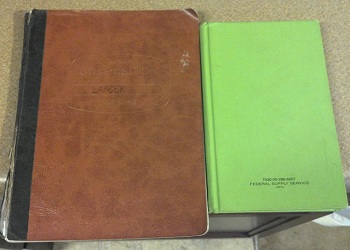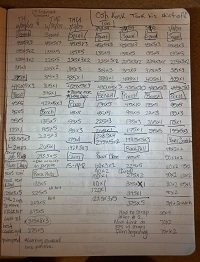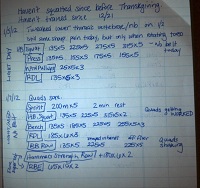Keeping a training log is incredibly important for all athletes, but especially for a strength trainee. Athletes and bodybuilders need to record their progress, yet athletes often do what they’re told and bodybuilders run a style of programming for a while and gauge progress by pictures. But for the strength trainee, numbers mean everything. If you lift more this week than you did a year ago, then you are obviously stronger. A training log easily quantifies progress and removes speculation and confusion. If you don’t keep a training log, then this post should convince you to do so. If you already keep one, this post may give you some additional variables to record or some ideas on how to organize the log itself.
What To Use
Any notebook will do, but notebooks without spirals will hold together. Composition books works really well, but they can still fall apart. Use duct or electrical tape to hold them together over the years and avoid turning the covers inside out. Chris has been using the same spiral notebook for several years, and it looks like he’s had it since fifth grade. The front cover is completely ripped off, but he keeps it on top as if it were still attached. The papers are loose, but some how he keeps it together enough where he can reference his training sessions (I’ve requested a picture). I don’t recommend this. Below are two types of notebooks that will hold up better:

The one on the left is a standard composition book, but with a leathery cover. The one on the right is a military field notebook; it was free and the cover is hard back and will hold up for a while. You can use whatever you want to, but I suggest picking something that will hold up for at least two years. My composition notebook above was used for at least 2.5 years.
CONTINUE READING
What Data To Record
How much data to record will depend on the habit of keeping a log. If you haven’t kept one before, keep it easy and just write down the date, exercises, sets, and reps. It’s helpful to record all of the warm-up sets. This way you can calculate the tonnage (weight x reps x sets) of the entire workout, but this isn’t really necessary (I haven’t ever done it, but it would be useful for intermediate level lifters). More importantly you can see how you felt based on the warm-up sets you did. I found out a couple years ago that I needed more warm-up sets on upper body exercises than I did for lower. I also learned that I needed at least a single right below the first work set weight. Recording all the sets, including warm-ups can let you find this information.
If recording the lifting data is a habit, then be sure to add in your comments. If a set felt great, point that out. If it felt like shit, point that out too. The next section will give two examples of my personal logs and you’ll see some quick comments. I’ll also point out if I felt pain in a given structure (i.e. “L. medial elbow pain” or “R. proximal hip flexor”). This way problem areas can be addressed in mobbing and you or your coach can keep an eye out for technical problems when lifting. I also like to record the day, time, and location of where I’m training. I’ve trained all over the world and had good and bad sessions. When I randomly matched a PR in the snatch and almost PR’d a CJ in Australia, I want to remember that and see what circumstances helped that (a medium day two days before probably helped).
Lastly, I like to put comment on how I feel when I start the session. If I’m feeling a bit sluggish, I’ll point that out. If you’re not feeling great going into a session, then consider how much sleep you’re getting. If it’s not enough sleep and you feel tired, then you know what to do. Of course you can wait and make notes on many of these data points if they are abnormal. Pointing out that your first squat set is “regular” may be superfluous, but if you destroyed it or had a bitch of a set, point that out.
How to Organize the Data
You can do pretty much whatever works for you. I will caution you to ensure that the data is easy to read and reference. If you’re trying to see what you did last week, or three months ago, you don’t want to spend more than a few seconds looking. I like to draw a rectangle around the name of the lift or exercise; doing so makes it easy to distinguish the rows or columns of data. I also like to draw a line signifying the work set. You’ll see in my old log that line is horizontal since my data is aligned in a column. In the newer log, I just draw a slash to signify the beginning of the work set since it’s organized in a horizontal row.
Note that there is about 2.5 weeks of information on this one page. This information is from the summer in 2009 when I was still chugging along on a linear progression. Cute. Also, the note on the top right of the page was something Chris wrote to make fun of me and somebody else. I hate when people write “notes” in my training log.
In this new log I organize things in rows. You can see how I note how I feel at the top of the day. As you can see, I hadn’t squatted since before Thanksgiving (the clean and jerk-a-thon really fucked me up) and hadn’t trained since before Christmas, so I did a light day and then a light/medium day. I did Hammer Strength rowing because my quads were shaking so bad when I was trying to do barbell rows.
Summary
Everyone should have a training log. If nothing else it will display whether or not a given program has worked. Use a notebook that won’t fall apart easily, and organize the information so it’s easy to read and reference. Once the habit of recording information is established, start recording additional information that will help you guide your training and programming. Some other things you could record that I didn’t are mobility workouts or emphasis (I put those on the left page of my new workout) and food intake (I only record this if it’s abnormally low). If you carry your training log while you’re training, it will make you look like you have your shit together. Otherwise, record it as soon as you get home; otherwise you’ll forget. The more you record, the better of you’ll be later when trying to reference the information.



What are your thoughts on Trapper Keepers?
Specifically, a sweet one like this to keep my eye on the prize.
http://images.mylot.com/userImages/images/postphotos/2291596.jpg
If it doesn’t look like this, you’re doing it wrong: http://img695.imageshack.us/img695/8881/galelabnotes.jpg
Paper … how quaint. I keep mine in a document on my laptop. This makes it easier to analyze the data when I want to.
Yeah I have a cool steno pad with NBHNC in bold black letters and then I drew a pagan sun wheel on the front for some gay reason. So now the CFers in my gym think its a pentagram and I worship satan and all I care about is buttholes. Which is like 80% true.
TL;DR
I would suggest RPE for exercises, too. That way you can guage the toughness of exercises. Also, bodyweight and food content if you’re feeling froggy.
Stroup-
Write down PR’s in blood. Preferably someone else’s.
Upon further review, there is evidence of RPE speak within the article. This results in a first down. *roll clock arm motion*
RPE is only allowed if you can deadlift at least 75% of Mike Tuscherer’s best deadlift.
Thanks for reminding me that I haven’t recorded anything about my training in several months.
Moleskin, baby, Moleskin.
This is why the Good Lord Sweet Crying Baby Jesus invented
1) Excel
B) Fitocracy.
I cant write my PRs in sweaty smudged ballpoint ink pen in excel you softcockmotherfuckers.
Is it normal to keep a log of other people at the gyms workouts? Or what they wear and smell like?
Sousa you would actually have to go to the gym to do that.
I can’t just hide in the bushes outside of it?
I dont really care for the excel things. I’m quite fastidious about my training log and it would only stress me out to have to keep up with it and an excel spread shit; besides, when Im actually working its all about fucking excel so I really don’t want to do more excel outside of work…
Sousak, your a silly sonofabitch
“I cant write my PRs in sweaty smudged ballpoint ink pen in excel you softcockmotherfuckers.”
hahahaha
–Justin
@Sousa having a ghillie suit of general insecurity with a sprinkle of shattered dreams and protein bar wrappers allows for closer observation than otherwise obtainable.
I’ve been keeping a training log since my first day of hard training on March 21, 2009. I use a horizontal layout similar to the second photo because I find it easier to refer back to. Also it makes it so you can have one week of training on each page, which is a helpful way to think about things during intermediate training. Every few months I input all of the data into an excel sheet. This takes a little bit of time but is well worth it because I can see a graphical representation of my progress over time. When I had trouble gaining weight and stalled on strength after about a year, I started tracking my calories and the relationship between the graph lines of calories consumed and weight lifted is incredibly telling.
I recently have started rating my mood (i.e. 1-sick, 2-sluggish, 3-headache, 4-doing it, 5-pumped, 6-pleased, 7-content, 8-hungry for more, 9-strong, 10-reckless). Yes it’s subjective but hopefully it will average out over time, so that’s going to be an additional line on the graph. I’m interested to see whether or not there is actually a correlation between how I feel and how I lift. My hypothesis is that mood 1-2= bad lifting, but anything 3- or higher will not affect performance.
It’s also really important to make funny/sarcastic comments about the silly bullshit witnessed in the gym because it’s awesome to look back on it later. I also find that I have moments of true philosophical insight while lifting–mostly coming out in the form of dirty jokes worthy of a Gilbert Godfried routine–so I write stuff like that down below each day’s work.
I was going to mention rating mood and how you feel physically. I’ve also considered having a workout tracking software available on this site that would do most of this (and much more) for you. Who would be interested?
–Justin
Keeping track of my training in a blog works for me. I kept it in a spreadsheet as well, but haven’t updated that for a while.
I like paper don’t want to fuck around on my computer entering data when I want a cool shower and some protein. I enjoy the tactility of pen and paper too.
Basically:
excel=nerd
paper=good
I keep a log of criminality that goes on in my gym, such as
-Brah training in ankle tag
-Guys discussing benefit fraud in the changing rooms
-Dude on the bench responding to death threats.
My PR in this was when some guy who trains there got fucking beheaded whilst trying to rob a Chinese dude’s house.
Keeping a log in important. I have been doing it for a few years and enjoy looking back. Keep mine similar to Justin’s but I have a line for Breakfast, Lunch, & Dinner. Write snacks between.
Just to let others know. Ebay has some good deals going on for the Adistar ClimaCool Olympic weightlifting shoes, these are the older model. You can save $100 picking these up compared to other sites. I am not the seller but I am a bidder!
My only RPE comments are when coaching RoryT and he says “I just want to die.” I write that down. Otherwise, I could be more intense.
Bought a log this morning, I named it Excel, that’s a win-win. I think it’s broken though, stupid thing won’t auto sum.
Maslow just gave me a nerdgasm. Graphs of weight lifted, calories consumed, AND mood? Omigod I would superimpose that shit into a SINGLE GRAPH and it would be so, so sexy.
My graphs end up in mspaint with curse words scribbled on them. Truth.
+1 for moleskin
Ugh, you show an obvious piece of government property and then say you got it free? Delete that picture and those comments.
Those service notebooks are cheap.
http://shop.manconinc.com/ProductDetails.aspx?ProdID=7530002223521&sku=7530002223521&id=11784
Always good to start with a memory-jog.
Maybe I’m just an asshole, but didn’t you just make a post criticizing Shawn for coming back after not training a month and ramping up to reps with 315…and then it appears you did the same?
You might be a good deal stronger, I don’t know…but still?
My quads were only mildly sore and then they were shaking a bit on the second day when doing barbell rows. You are observant to remember the Shawn post, but, good sir, did you miss how I pointed out that the first and second days were Light and Light/Medium days? It says so in the margin of the picture.
This is why I do not have a public training log.
–Justin
Also, Maslow, sounds pretty cool, I’ve been wanting to make something like that. If/when I do (maybe my next school break?), I’ll try to post it to the site. Any chance you want to share yours in the meantime?
Did I miss a memo? What’s going on with http://www.startingstrength.com ?
I have no idea. I’m not involved with that website.
–Justin
I’d definitely take advantage of a program to track workouts. Right now I keep a log on ironstrong.org
Yes to a program to track progress. If I had any kind of programming skills I would love to have an app where I could plug in my numbers while at the gym and have it sync to a site that graphs my progress.
Use Rite in the Rain Field books from Forestry Suppliers:
http://www.forestry-suppliers.com/product_pages/View_Catalog_Page.asp?mi=3274&title=%E2%80%9CRite+in+the+Rain%E2%80%9D%C2+Environmental+Field+Books+with+Reference
@Cloud
I did wanna die. That was the most terrible bench workout of my life.
Good thing today’s bench is gonna be awesome!
Pingback: Post Comments: Max pull ups, 400m run- Thursday January 26th, 2012, Spouse’s Day » Denver Crossfit LoDo - Gym
Pingback: Post Comments: Heavy Cleans- Friday January 27th, 2012, Punch the Clock Day » Denver Crossfit LoDo - Gym
Pingback: » Q&A – 16
Pingback: Post Comments: Free WOD -Sunday January 29th, 2012, National Puzzle Day » Denver Crossfit LoDo - Gym
Pingback: Post Comments: “McGhee” WOD -Sunday January 29th, 2012, National Puzzle Day » Denver Crossfit LoDo - Gym
Pingback: Monday 9.30.13 « Crossfit South Bend blog